A Literature Review of Environmental Risks in Maritime Logistics
VerifiedAdded on 2023/06/10
|31
|8316
|109
Literature Review
AI Summary
This literature review examines risk management within the context of maritime logistics, with a particular focus on environmental risks and Australian cases. It begins by defining maritime logistics and outlining its key activities, including the transportation of various types of cargo. The review then discusses the losses and risks inherent in the global maritime industry, categorizing them and highlighting environmental risks. It elaborates on the risk management process, including risk identification, evaluation, mitigation, and monitoring. The review also explores different risk management approaches used in the maritime logistics sector. This document is available on Desklib, a platform offering a wealth of study resources for students.
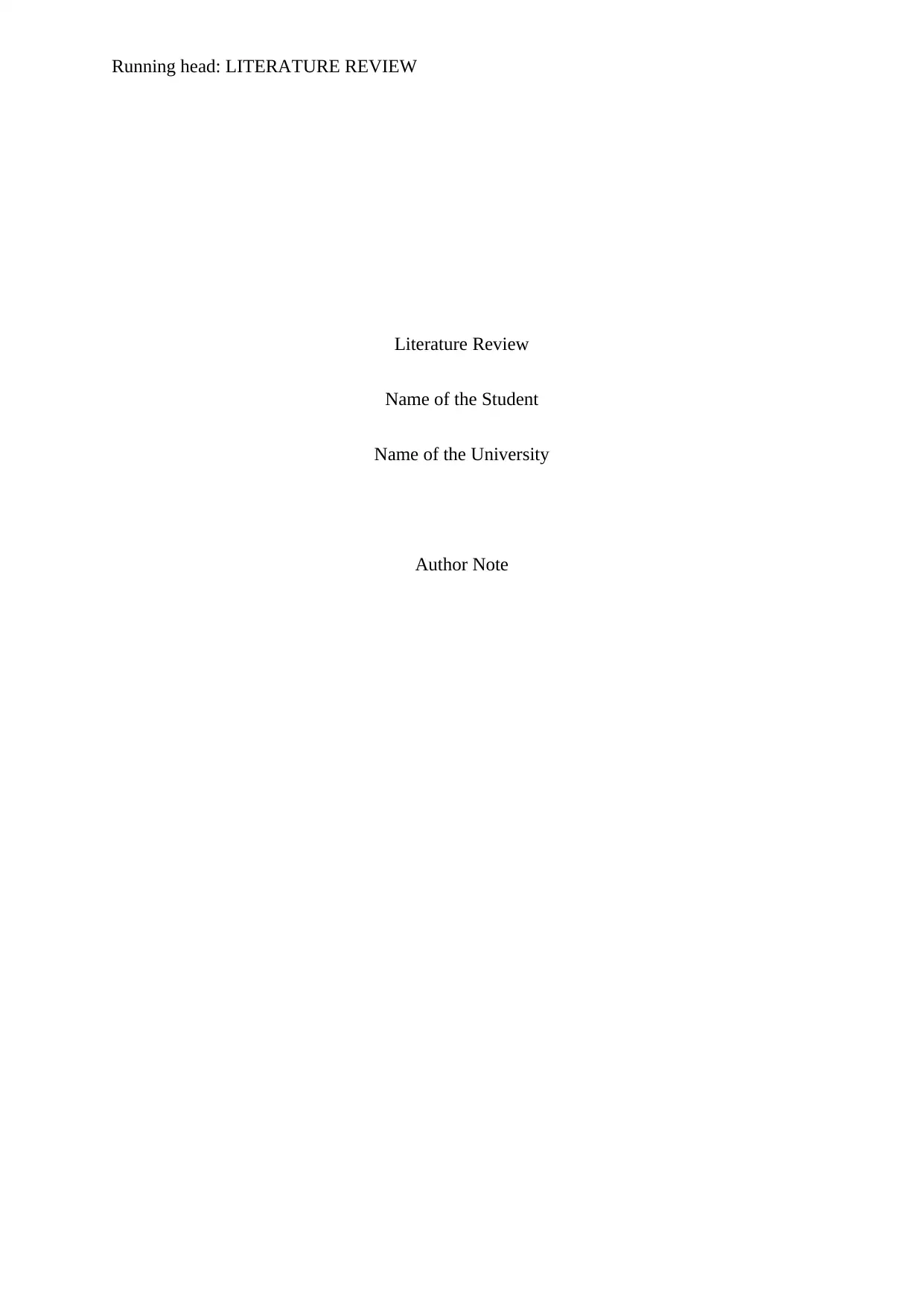
Running head: LITERATURE REVIEW
Literature Review
Name of the Student
Name of the University
Author Note
Literature Review
Name of the Student
Name of the University
Author Note
Paraphrase This Document
Need a fresh take? Get an instant paraphrase of this document with our AI Paraphraser
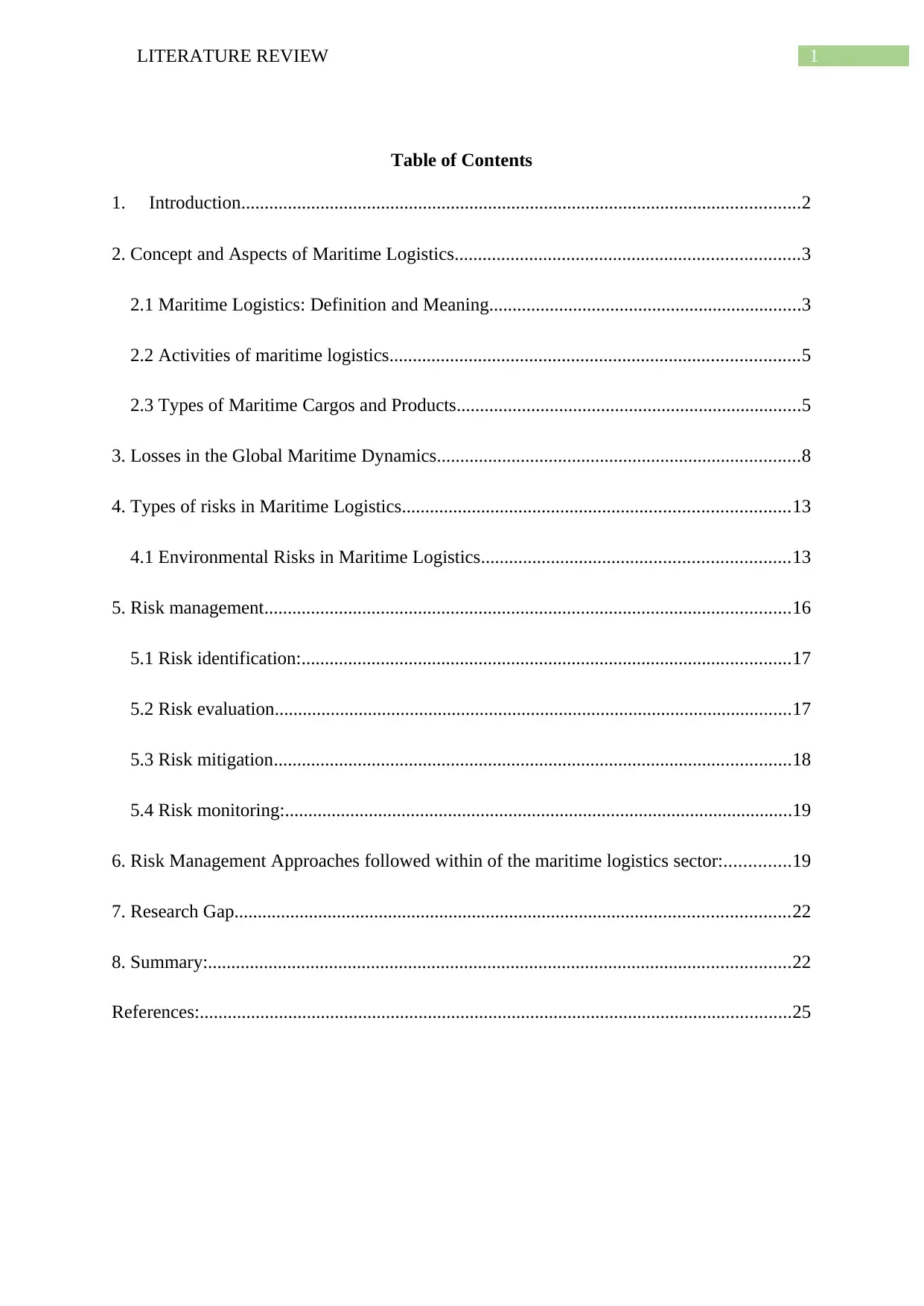
1LITERATURE REVIEW
Table of Contents
1. Introduction........................................................................................................................2
2. Concept and Aspects of Maritime Logistics..........................................................................3
2.1 Maritime Logistics: Definition and Meaning...................................................................3
2.2 Activities of maritime logistics........................................................................................5
2.3 Types of Maritime Cargos and Products..........................................................................5
3. Losses in the Global Maritime Dynamics..............................................................................8
4. Types of risks in Maritime Logistics...................................................................................13
4.1 Environmental Risks in Maritime Logistics..................................................................13
5. Risk management.................................................................................................................16
5.1 Risk identification:.........................................................................................................17
5.2 Risk evaluation...............................................................................................................17
5.3 Risk mitigation...............................................................................................................18
5.4 Risk monitoring:.............................................................................................................19
6. Risk Management Approaches followed within of the maritime logistics sector:..............19
7. Research Gap.......................................................................................................................22
8. Summary:.............................................................................................................................22
References:...............................................................................................................................25
Table of Contents
1. Introduction........................................................................................................................2
2. Concept and Aspects of Maritime Logistics..........................................................................3
2.1 Maritime Logistics: Definition and Meaning...................................................................3
2.2 Activities of maritime logistics........................................................................................5
2.3 Types of Maritime Cargos and Products..........................................................................5
3. Losses in the Global Maritime Dynamics..............................................................................8
4. Types of risks in Maritime Logistics...................................................................................13
4.1 Environmental Risks in Maritime Logistics..................................................................13
5. Risk management.................................................................................................................16
5.1 Risk identification:.........................................................................................................17
5.2 Risk evaluation...............................................................................................................17
5.3 Risk mitigation...............................................................................................................18
5.4 Risk monitoring:.............................................................................................................19
6. Risk Management Approaches followed within of the maritime logistics sector:..............19
7. Research Gap.......................................................................................................................22
8. Summary:.............................................................................................................................22
References:...............................................................................................................................25
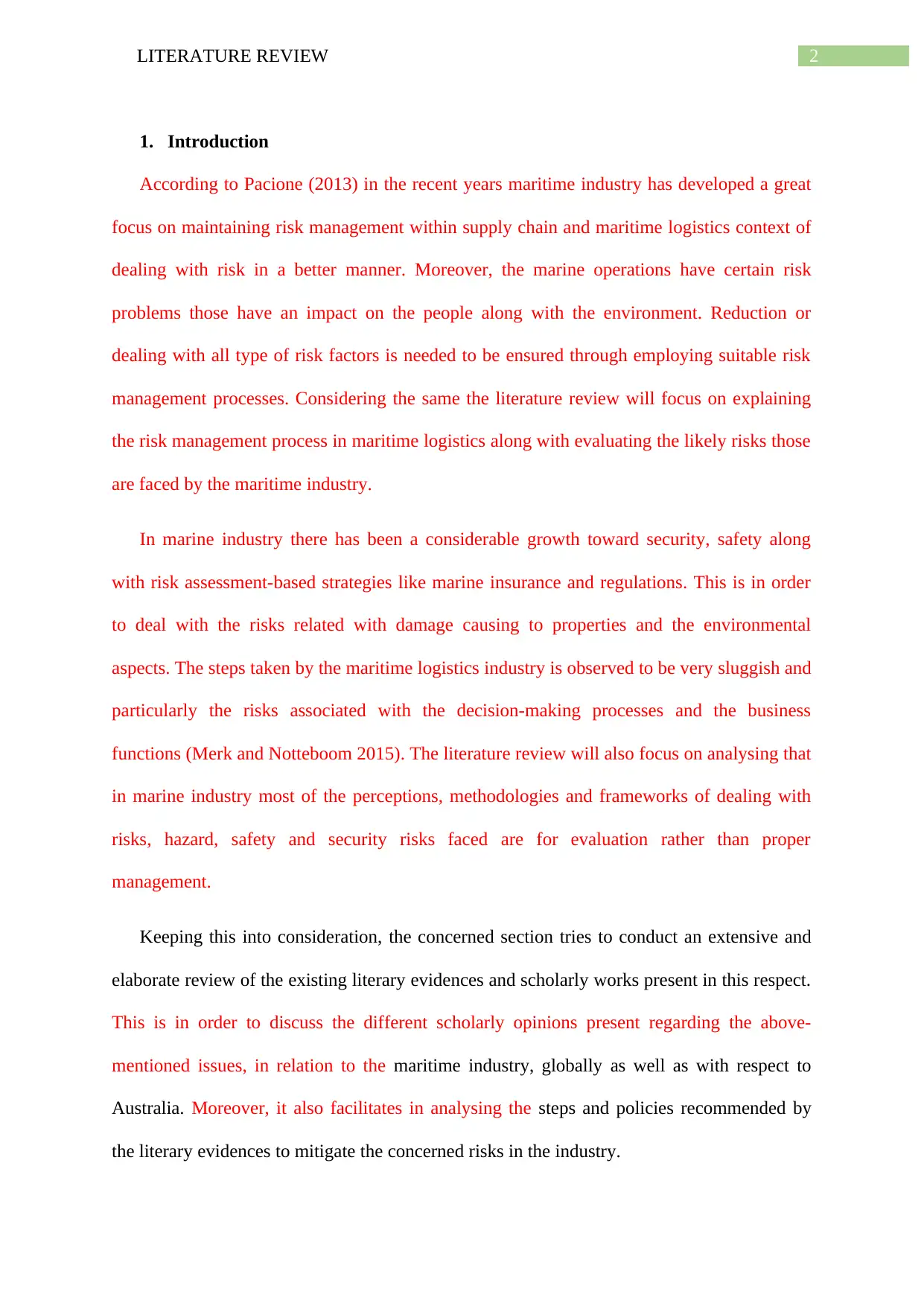
2LITERATURE REVIEW
1. Introduction
According to Pacione (2013) in the recent years maritime industry has developed a great
focus on maintaining risk management within supply chain and maritime logistics context of
dealing with risk in a better manner. Moreover, the marine operations have certain risk
problems those have an impact on the people along with the environment. Reduction or
dealing with all type of risk factors is needed to be ensured through employing suitable risk
management processes. Considering the same the literature review will focus on explaining
the risk management process in maritime logistics along with evaluating the likely risks those
are faced by the maritime industry.
In marine industry there has been a considerable growth toward security, safety along
with risk assessment-based strategies like marine insurance and regulations. This is in order
to deal with the risks related with damage causing to properties and the environmental
aspects. The steps taken by the maritime logistics industry is observed to be very sluggish and
particularly the risks associated with the decision-making processes and the business
functions (Merk and Notteboom 2015). The literature review will also focus on analysing that
in marine industry most of the perceptions, methodologies and frameworks of dealing with
risks, hazard, safety and security risks faced are for evaluation rather than proper
management.
Keeping this into consideration, the concerned section tries to conduct an extensive and
elaborate review of the existing literary evidences and scholarly works present in this respect.
This is in order to discuss the different scholarly opinions present regarding the above-
mentioned issues, in relation to the maritime industry, globally as well as with respect to
Australia. Moreover, it also facilitates in analysing the steps and policies recommended by
the literary evidences to mitigate the concerned risks in the industry.
1. Introduction
According to Pacione (2013) in the recent years maritime industry has developed a great
focus on maintaining risk management within supply chain and maritime logistics context of
dealing with risk in a better manner. Moreover, the marine operations have certain risk
problems those have an impact on the people along with the environment. Reduction or
dealing with all type of risk factors is needed to be ensured through employing suitable risk
management processes. Considering the same the literature review will focus on explaining
the risk management process in maritime logistics along with evaluating the likely risks those
are faced by the maritime industry.
In marine industry there has been a considerable growth toward security, safety along
with risk assessment-based strategies like marine insurance and regulations. This is in order
to deal with the risks related with damage causing to properties and the environmental
aspects. The steps taken by the maritime logistics industry is observed to be very sluggish and
particularly the risks associated with the decision-making processes and the business
functions (Merk and Notteboom 2015). The literature review will also focus on analysing that
in marine industry most of the perceptions, methodologies and frameworks of dealing with
risks, hazard, safety and security risks faced are for evaluation rather than proper
management.
Keeping this into consideration, the concerned section tries to conduct an extensive and
elaborate review of the existing literary evidences and scholarly works present in this respect.
This is in order to discuss the different scholarly opinions present regarding the above-
mentioned issues, in relation to the maritime industry, globally as well as with respect to
Australia. Moreover, it also facilitates in analysing the steps and policies recommended by
the literary evidences to mitigate the concerned risks in the industry.
⊘ This is a preview!⊘
Do you want full access?
Subscribe today to unlock all pages.

Trusted by 1+ million students worldwide
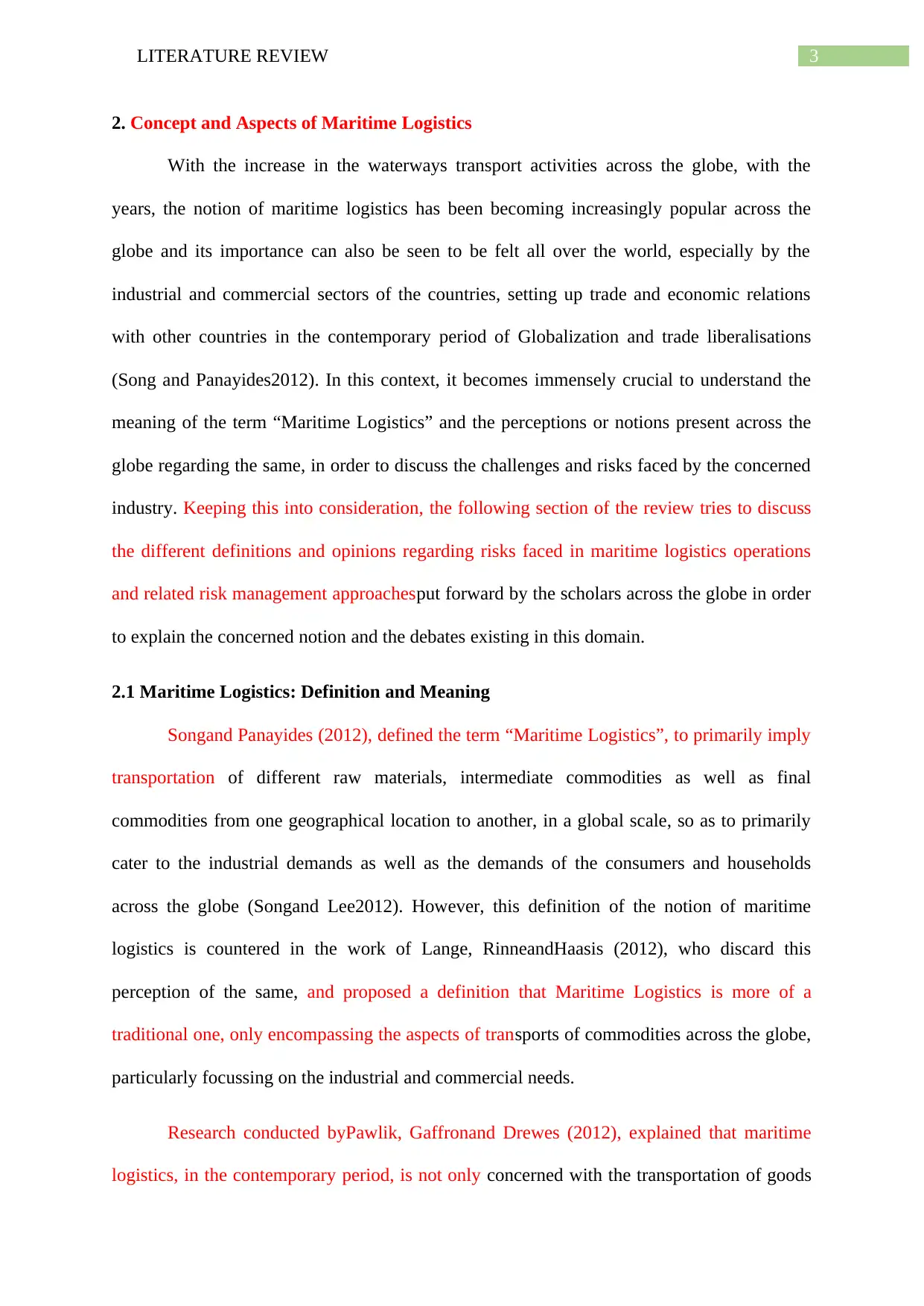
3LITERATURE REVIEW
2. Concept and Aspects of Maritime Logistics
With the increase in the waterways transport activities across the globe, with the
years, the notion of maritime logistics has been becoming increasingly popular across the
globe and its importance can also be seen to be felt all over the world, especially by the
industrial and commercial sectors of the countries, setting up trade and economic relations
with other countries in the contemporary period of Globalization and trade liberalisations
(Song and Panayides2012). In this context, it becomes immensely crucial to understand the
meaning of the term “Maritime Logistics” and the perceptions or notions present across the
globe regarding the same, in order to discuss the challenges and risks faced by the concerned
industry. Keeping this into consideration, the following section of the review tries to discuss
the different definitions and opinions regarding risks faced in maritime logistics operations
and related risk management approachesput forward by the scholars across the globe in order
to explain the concerned notion and the debates existing in this domain.
2.1 Maritime Logistics: Definition and Meaning
Songand Panayides (2012), defined the term “Maritime Logistics”, to primarily imply
transportation of different raw materials, intermediate commodities as well as final
commodities from one geographical location to another, in a global scale, so as to primarily
cater to the industrial demands as well as the demands of the consumers and households
across the globe (Songand Lee2012). However, this definition of the notion of maritime
logistics is countered in the work of Lange, RinneandHaasis (2012), who discard this
perception of the same, and proposed a definition that Maritime Logistics is more of a
traditional one, only encompassing the aspects of transports of commodities across the globe,
particularly focussing on the industrial and commercial needs.
Research conducted byPawlik, Gaffronand Drewes (2012), explained that maritime
logistics, in the contemporary period, is not only concerned with the transportation of goods
2. Concept and Aspects of Maritime Logistics
With the increase in the waterways transport activities across the globe, with the
years, the notion of maritime logistics has been becoming increasingly popular across the
globe and its importance can also be seen to be felt all over the world, especially by the
industrial and commercial sectors of the countries, setting up trade and economic relations
with other countries in the contemporary period of Globalization and trade liberalisations
(Song and Panayides2012). In this context, it becomes immensely crucial to understand the
meaning of the term “Maritime Logistics” and the perceptions or notions present across the
globe regarding the same, in order to discuss the challenges and risks faced by the concerned
industry. Keeping this into consideration, the following section of the review tries to discuss
the different definitions and opinions regarding risks faced in maritime logistics operations
and related risk management approachesput forward by the scholars across the globe in order
to explain the concerned notion and the debates existing in this domain.
2.1 Maritime Logistics: Definition and Meaning
Songand Panayides (2012), defined the term “Maritime Logistics”, to primarily imply
transportation of different raw materials, intermediate commodities as well as final
commodities from one geographical location to another, in a global scale, so as to primarily
cater to the industrial demands as well as the demands of the consumers and households
across the globe (Songand Lee2012). However, this definition of the notion of maritime
logistics is countered in the work of Lange, RinneandHaasis (2012), who discard this
perception of the same, and proposed a definition that Maritime Logistics is more of a
traditional one, only encompassing the aspects of transports of commodities across the globe,
particularly focussing on the industrial and commercial needs.
Research conducted byPawlik, Gaffronand Drewes (2012), explained that maritime
logistics, in the contemporary period, is not only concerned with the transportation of goods
Paraphrase This Document
Need a fresh take? Get an instant paraphrase of this document with our AI Paraphraser
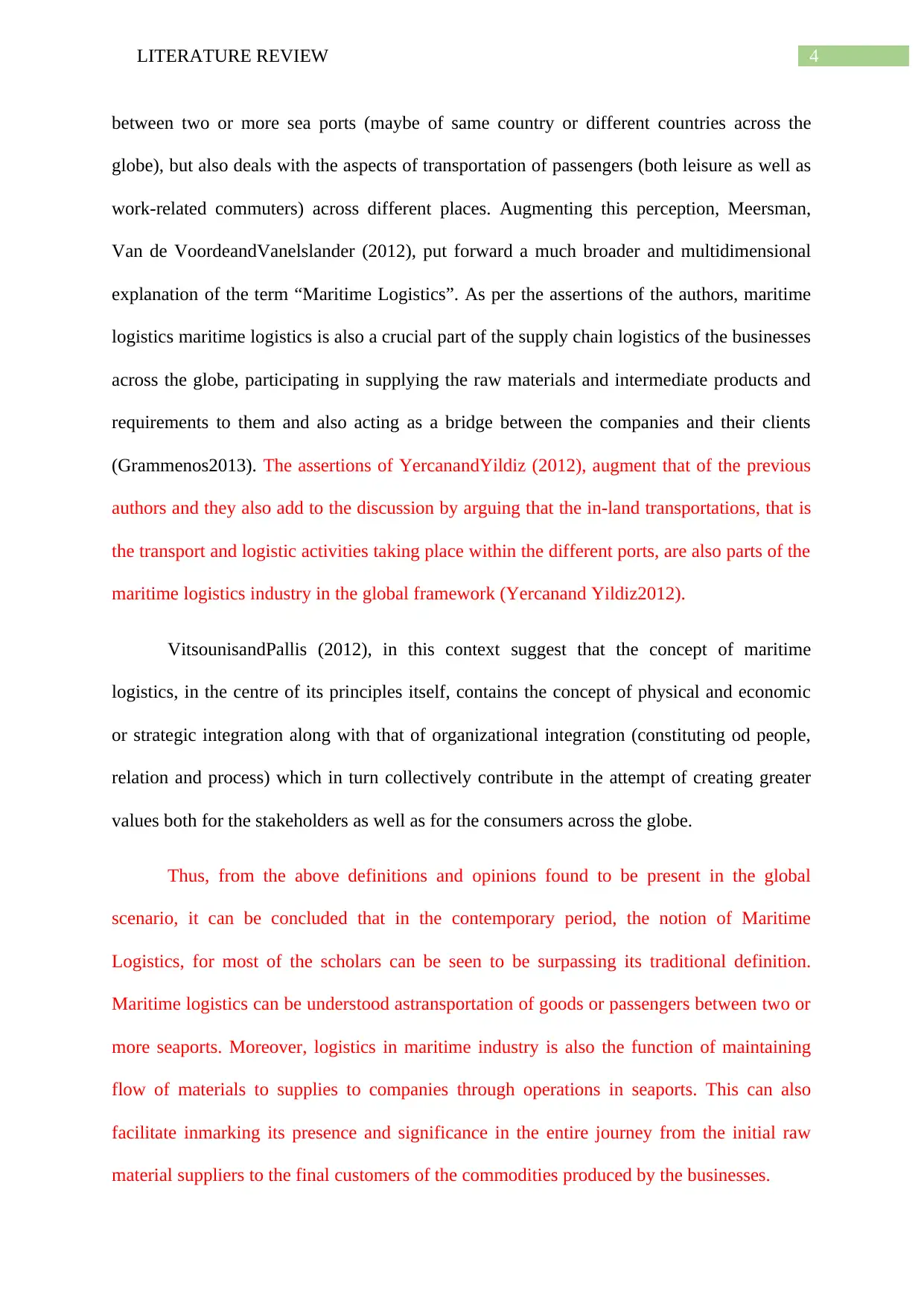
4LITERATURE REVIEW
between two or more sea ports (maybe of same country or different countries across the
globe), but also deals with the aspects of transportation of passengers (both leisure as well as
work-related commuters) across different places. Augmenting this perception, Meersman,
Van de VoordeandVanelslander (2012), put forward a much broader and multidimensional
explanation of the term “Maritime Logistics”. As per the assertions of the authors, maritime
logistics maritime logistics is also a crucial part of the supply chain logistics of the businesses
across the globe, participating in supplying the raw materials and intermediate products and
requirements to them and also acting as a bridge between the companies and their clients
(Grammenos2013). The assertions of YercanandYildiz (2012), augment that of the previous
authors and they also add to the discussion by arguing that the in-land transportations, that is
the transport and logistic activities taking place within the different ports, are also parts of the
maritime logistics industry in the global framework (Yercanand Yildiz2012).
VitsounisandPallis (2012), in this context suggest that the concept of maritime
logistics, in the centre of its principles itself, contains the concept of physical and economic
or strategic integration along with that of organizational integration (constituting od people,
relation and process) which in turn collectively contribute in the attempt of creating greater
values both for the stakeholders as well as for the consumers across the globe.
Thus, from the above definitions and opinions found to be present in the global
scenario, it can be concluded that in the contemporary period, the notion of Maritime
Logistics, for most of the scholars can be seen to be surpassing its traditional definition.
Maritime logistics can be understood astransportation of goods or passengers between two or
more seaports. Moreover, logistics in maritime industry is also the function of maintaining
flow of materials to supplies to companies through operations in seaports. This can also
facilitate inmarking its presence and significance in the entire journey from the initial raw
material suppliers to the final customers of the commodities produced by the businesses.
between two or more sea ports (maybe of same country or different countries across the
globe), but also deals with the aspects of transportation of passengers (both leisure as well as
work-related commuters) across different places. Augmenting this perception, Meersman,
Van de VoordeandVanelslander (2012), put forward a much broader and multidimensional
explanation of the term “Maritime Logistics”. As per the assertions of the authors, maritime
logistics maritime logistics is also a crucial part of the supply chain logistics of the businesses
across the globe, participating in supplying the raw materials and intermediate products and
requirements to them and also acting as a bridge between the companies and their clients
(Grammenos2013). The assertions of YercanandYildiz (2012), augment that of the previous
authors and they also add to the discussion by arguing that the in-land transportations, that is
the transport and logistic activities taking place within the different ports, are also parts of the
maritime logistics industry in the global framework (Yercanand Yildiz2012).
VitsounisandPallis (2012), in this context suggest that the concept of maritime
logistics, in the centre of its principles itself, contains the concept of physical and economic
or strategic integration along with that of organizational integration (constituting od people,
relation and process) which in turn collectively contribute in the attempt of creating greater
values both for the stakeholders as well as for the consumers across the globe.
Thus, from the above definitions and opinions found to be present in the global
scenario, it can be concluded that in the contemporary period, the notion of Maritime
Logistics, for most of the scholars can be seen to be surpassing its traditional definition.
Maritime logistics can be understood astransportation of goods or passengers between two or
more seaports. Moreover, logistics in maritime industry is also the function of maintaining
flow of materials to supplies to companies through operations in seaports. This can also
facilitate inmarking its presence and significance in the entire journey from the initial raw
material suppliers to the final customers of the commodities produced by the businesses.
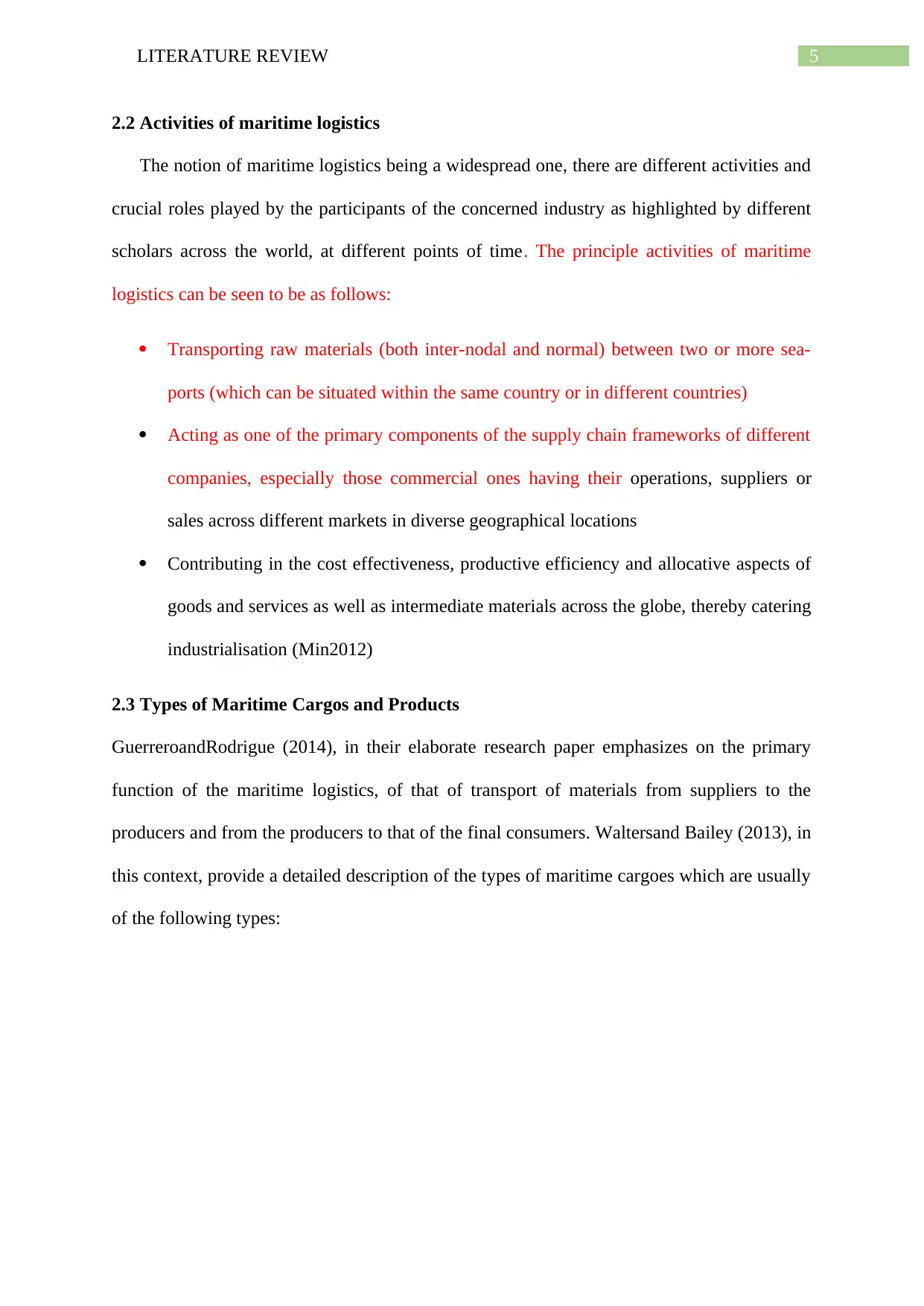
5LITERATURE REVIEW
2.2 Activities of maritime logistics
The notion of maritime logistics being a widespread one, there are different activities and
crucial roles played by the participants of the concerned industry as highlighted by different
scholars across the world, at different points of time. The principle activities of maritime
logistics can be seen to be as follows:
Transporting raw materials (both inter-nodal and normal) between two or more sea-
ports (which can be situated within the same country or in different countries)
Acting as one of the primary components of the supply chain frameworks of different
companies, especially those commercial ones having their operations, suppliers or
sales across different markets in diverse geographical locations
Contributing in the cost effectiveness, productive efficiency and allocative aspects of
goods and services as well as intermediate materials across the globe, thereby catering
industrialisation (Min2012)
2.3 Types of Maritime Cargos and Products
GuerreroandRodrigue (2014), in their elaborate research paper emphasizes on the primary
function of the maritime logistics, of that of transport of materials from suppliers to the
producers and from the producers to that of the final consumers. Waltersand Bailey (2013), in
this context, provide a detailed description of the types of maritime cargoes which are usually
of the following types:
2.2 Activities of maritime logistics
The notion of maritime logistics being a widespread one, there are different activities and
crucial roles played by the participants of the concerned industry as highlighted by different
scholars across the world, at different points of time. The principle activities of maritime
logistics can be seen to be as follows:
Transporting raw materials (both inter-nodal and normal) between two or more sea-
ports (which can be situated within the same country or in different countries)
Acting as one of the primary components of the supply chain frameworks of different
companies, especially those commercial ones having their operations, suppliers or
sales across different markets in diverse geographical locations
Contributing in the cost effectiveness, productive efficiency and allocative aspects of
goods and services as well as intermediate materials across the globe, thereby catering
industrialisation (Min2012)
2.3 Types of Maritime Cargos and Products
GuerreroandRodrigue (2014), in their elaborate research paper emphasizes on the primary
function of the maritime logistics, of that of transport of materials from suppliers to the
producers and from the producers to that of the final consumers. Waltersand Bailey (2013), in
this context, provide a detailed description of the types of maritime cargoes which are usually
of the following types:
⊘ This is a preview!⊘
Do you want full access?
Subscribe today to unlock all pages.

Trusted by 1+ million students worldwide
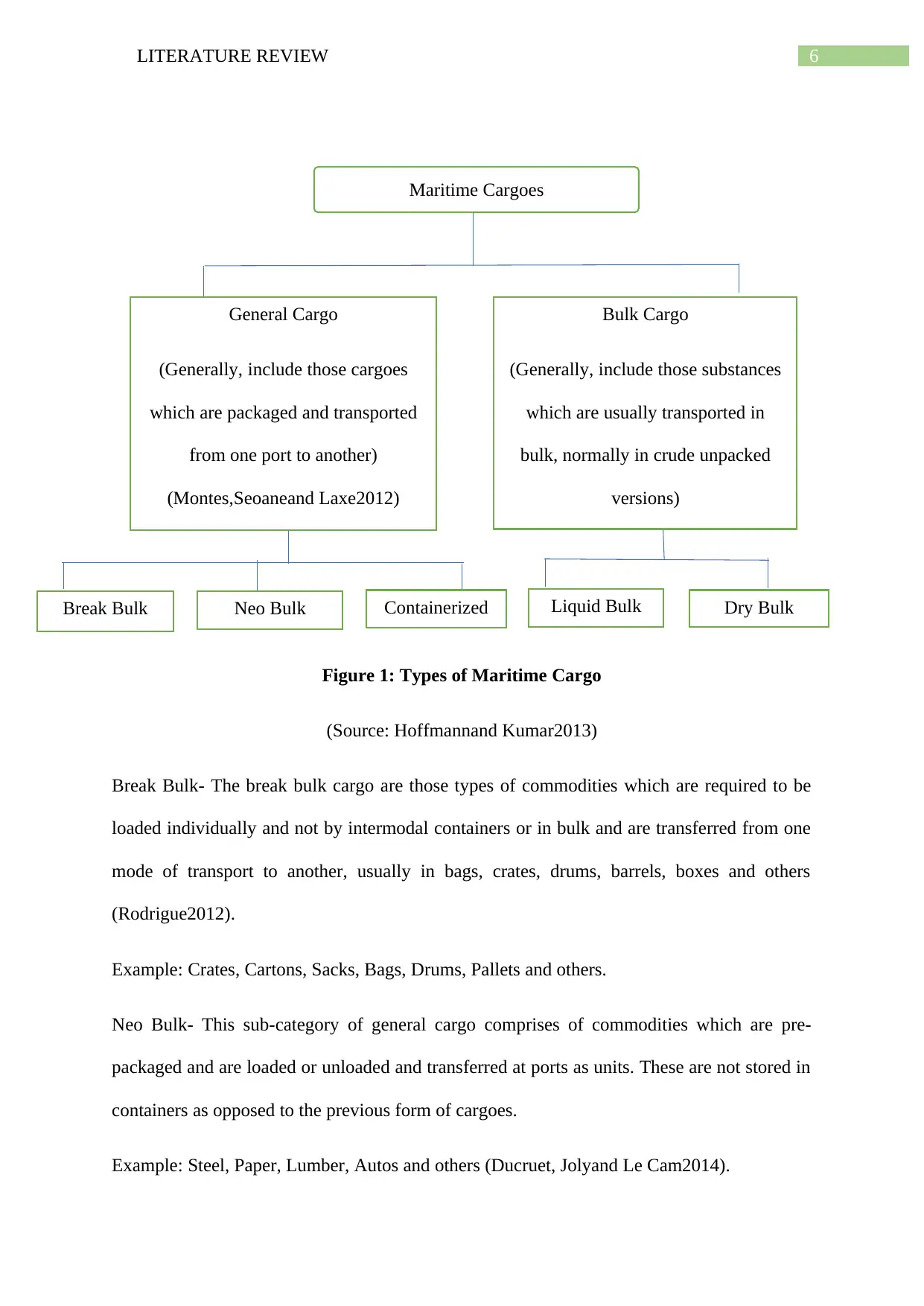
6LITERATURE REVIEW
Figure 1: Types of Maritime Cargo
(Source: Hoffmannand Kumar2013)
Break Bulk- The break bulk cargo are those types of commodities which are required to be
loaded individually and not by intermodal containers or in bulk and are transferred from one
mode of transport to another, usually in bags, crates, drums, barrels, boxes and others
(Rodrigue2012).
Example: Crates, Cartons, Sacks, Bags, Drums, Pallets and others.
Neo Bulk- This sub-category of general cargo comprises of commodities which are pre-
packaged and are loaded or unloaded and transferred at ports as units. These are not stored in
containers as opposed to the previous form of cargoes.
Example: Steel, Paper, Lumber, Autos and others (Ducruet, Jolyand Le Cam2014).
Maritime Cargoes
General Cargo
(Generally, include those cargoes
which are packaged and transported
from one port to another)
(Montes,Seoaneand Laxe2012)
Bulk Cargo
(Generally, include those substances
which are usually transported in
bulk, normally in crude unpacked
versions)
Break Bulk Neo Bulk Containerized Liquid Bulk Dry Bulk
Figure 1: Types of Maritime Cargo
(Source: Hoffmannand Kumar2013)
Break Bulk- The break bulk cargo are those types of commodities which are required to be
loaded individually and not by intermodal containers or in bulk and are transferred from one
mode of transport to another, usually in bags, crates, drums, barrels, boxes and others
(Rodrigue2012).
Example: Crates, Cartons, Sacks, Bags, Drums, Pallets and others.
Neo Bulk- This sub-category of general cargo comprises of commodities which are pre-
packaged and are loaded or unloaded and transferred at ports as units. These are not stored in
containers as opposed to the previous form of cargoes.
Example: Steel, Paper, Lumber, Autos and others (Ducruet, Jolyand Le Cam2014).
Maritime Cargoes
General Cargo
(Generally, include those cargoes
which are packaged and transported
from one port to another)
(Montes,Seoaneand Laxe2012)
Bulk Cargo
(Generally, include those substances
which are usually transported in
bulk, normally in crude unpacked
versions)
Break Bulk Neo Bulk Containerized Liquid Bulk Dry Bulk
Paraphrase This Document
Need a fresh take? Get an instant paraphrase of this document with our AI Paraphraser

7LITERATURE REVIEW
Containerized Cargo- Laxe, Seoaneand Montes (2012), define the process of
containerization, in context of maritime logistic activities as the process of intermodal
transport of freights with the help of containers (which are also known as shipping containers
or ISO containers), which usually have globally conventional and standardized dimensions.
The containerized cargoes are loaded, unloaded, transported and stacked for long distances
and can also be transferred from one transport mode to another (Bellet al. 2013). The
handling of containerized cargoes is usually mechanized with numbering and tracking
systems for each of crates with the help of computerized systems.
Example: Lift on Lift off containers, Roll on Roll off containers
Liquid Bulk- These types of cargoes are liquid in nature and are usually transported in bulk or
large quantities in unpacked manners, that is, in their crude forms.
Example: Petroleum, LNG, Chemicals, Vegetable Oil, Molasses and others.
Dry Bulk- The maritime logistics not only deal with liquid forms of bulk cargoes but also
involve in transporting dry forms of commodities in bulk.
Example: Grains, Gravel, Scrap, Sand, Clinker, Fertilizer, Coal, Metal and others (Lee and
Lee2016).
The increase in the industrialisation has led to the need for transporting huge bulk
freight across the globes, which primarily include both dry as well as liquid bulk freights
which can be minor as well as major bulks, as can be seen from the ton-miles shipped by the
Maritime Transportation across the globe (Acciaro 2013). This can be seen from the
following figure:
Containerized Cargo- Laxe, Seoaneand Montes (2012), define the process of
containerization, in context of maritime logistic activities as the process of intermodal
transport of freights with the help of containers (which are also known as shipping containers
or ISO containers), which usually have globally conventional and standardized dimensions.
The containerized cargoes are loaded, unloaded, transported and stacked for long distances
and can also be transferred from one transport mode to another (Bellet al. 2013). The
handling of containerized cargoes is usually mechanized with numbering and tracking
systems for each of crates with the help of computerized systems.
Example: Lift on Lift off containers, Roll on Roll off containers
Liquid Bulk- These types of cargoes are liquid in nature and are usually transported in bulk or
large quantities in unpacked manners, that is, in their crude forms.
Example: Petroleum, LNG, Chemicals, Vegetable Oil, Molasses and others.
Dry Bulk- The maritime logistics not only deal with liquid forms of bulk cargoes but also
involve in transporting dry forms of commodities in bulk.
Example: Grains, Gravel, Scrap, Sand, Clinker, Fertilizer, Coal, Metal and others (Lee and
Lee2016).
The increase in the industrialisation has led to the need for transporting huge bulk
freight across the globes, which primarily include both dry as well as liquid bulk freights
which can be minor as well as major bulks, as can be seen from the ton-miles shipped by the
Maritime Transportation across the globe (Acciaro 2013). This can be seen from the
following figure:
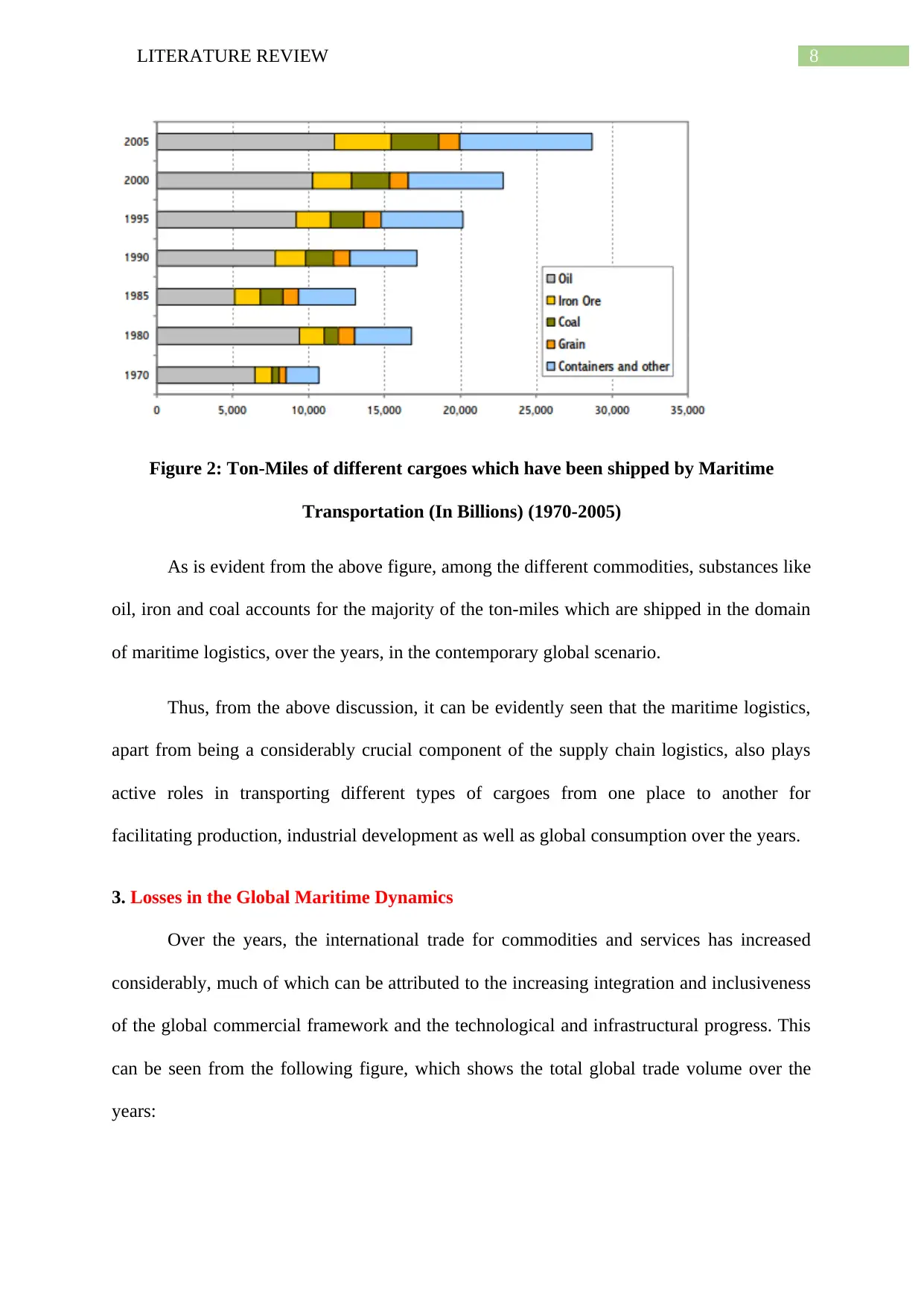
8LITERATURE REVIEW
Figure 2: Ton-Miles of different cargoes which have been shipped by Maritime
Transportation (In Billions) (1970-2005)
As is evident from the above figure, among the different commodities, substances like
oil, iron and coal accounts for the majority of the ton-miles which are shipped in the domain
of maritime logistics, over the years, in the contemporary global scenario.
Thus, from the above discussion, it can be evidently seen that the maritime logistics,
apart from being a considerably crucial component of the supply chain logistics, also plays
active roles in transporting different types of cargoes from one place to another for
facilitating production, industrial development as well as global consumption over the years.
3. Losses in the Global Maritime Dynamics
Over the years, the international trade for commodities and services has increased
considerably, much of which can be attributed to the increasing integration and inclusiveness
of the global commercial framework and the technological and infrastructural progress. This
can be seen from the following figure, which shows the total global trade volume over the
years:
Figure 2: Ton-Miles of different cargoes which have been shipped by Maritime
Transportation (In Billions) (1970-2005)
As is evident from the above figure, among the different commodities, substances like
oil, iron and coal accounts for the majority of the ton-miles which are shipped in the domain
of maritime logistics, over the years, in the contemporary global scenario.
Thus, from the above discussion, it can be evidently seen that the maritime logistics,
apart from being a considerably crucial component of the supply chain logistics, also plays
active roles in transporting different types of cargoes from one place to another for
facilitating production, industrial development as well as global consumption over the years.
3. Losses in the Global Maritime Dynamics
Over the years, the international trade for commodities and services has increased
considerably, much of which can be attributed to the increasing integration and inclusiveness
of the global commercial framework and the technological and infrastructural progress. This
can be seen from the following figure, which shows the total global trade volume over the
years:
⊘ This is a preview!⊘
Do you want full access?
Subscribe today to unlock all pages.

Trusted by 1+ million students worldwide

9LITERATURE REVIEW
Figure 3: Dynamics in the global commercial scenario and trade volumes over the years
(Source: Epa.gov2018)
As is evident from the above figure, over the years, the world merchandise trade
volume has increased significantly and more or less stably, barring the period between 2007-
2008. Eatonet al. (2016), attributes this temporary slowdown of both the global merchandise
trade as well as the global GDP dynamics to the Global Financial Crisis of 2007-2008, which
led to an international slowdown and recessionary situation across the world. Both the
dynamics, however, can be seen to be gaining pace post-recession. In context to this, the
global sea-borne trade can also be seen to be increasing at a rapid rate, with the pattern of
growth of the sea-borne trade being similar to that of the dynamics of the global merchandise
trade (Athukorala2014).
MaurerandDegain (2012), in their empirically evidenced paper, highlights another
important dynamic in the global maritime logistics in the aspect of vessel capacities.
According to the authors, with time, not only the trade volumes by waterways increased, but
Figure 3: Dynamics in the global commercial scenario and trade volumes over the years
(Source: Epa.gov2018)
As is evident from the above figure, over the years, the world merchandise trade
volume has increased significantly and more or less stably, barring the period between 2007-
2008. Eatonet al. (2016), attributes this temporary slowdown of both the global merchandise
trade as well as the global GDP dynamics to the Global Financial Crisis of 2007-2008, which
led to an international slowdown and recessionary situation across the world. Both the
dynamics, however, can be seen to be gaining pace post-recession. In context to this, the
global sea-borne trade can also be seen to be increasing at a rapid rate, with the pattern of
growth of the sea-borne trade being similar to that of the dynamics of the global merchandise
trade (Athukorala2014).
MaurerandDegain (2012), in their empirically evidenced paper, highlights another
important dynamic in the global maritime logistics in the aspect of vessel capacities.
According to the authors, with time, not only the trade volumes by waterways increased, but
Paraphrase This Document
Need a fresh take? Get an instant paraphrase of this document with our AI Paraphraser
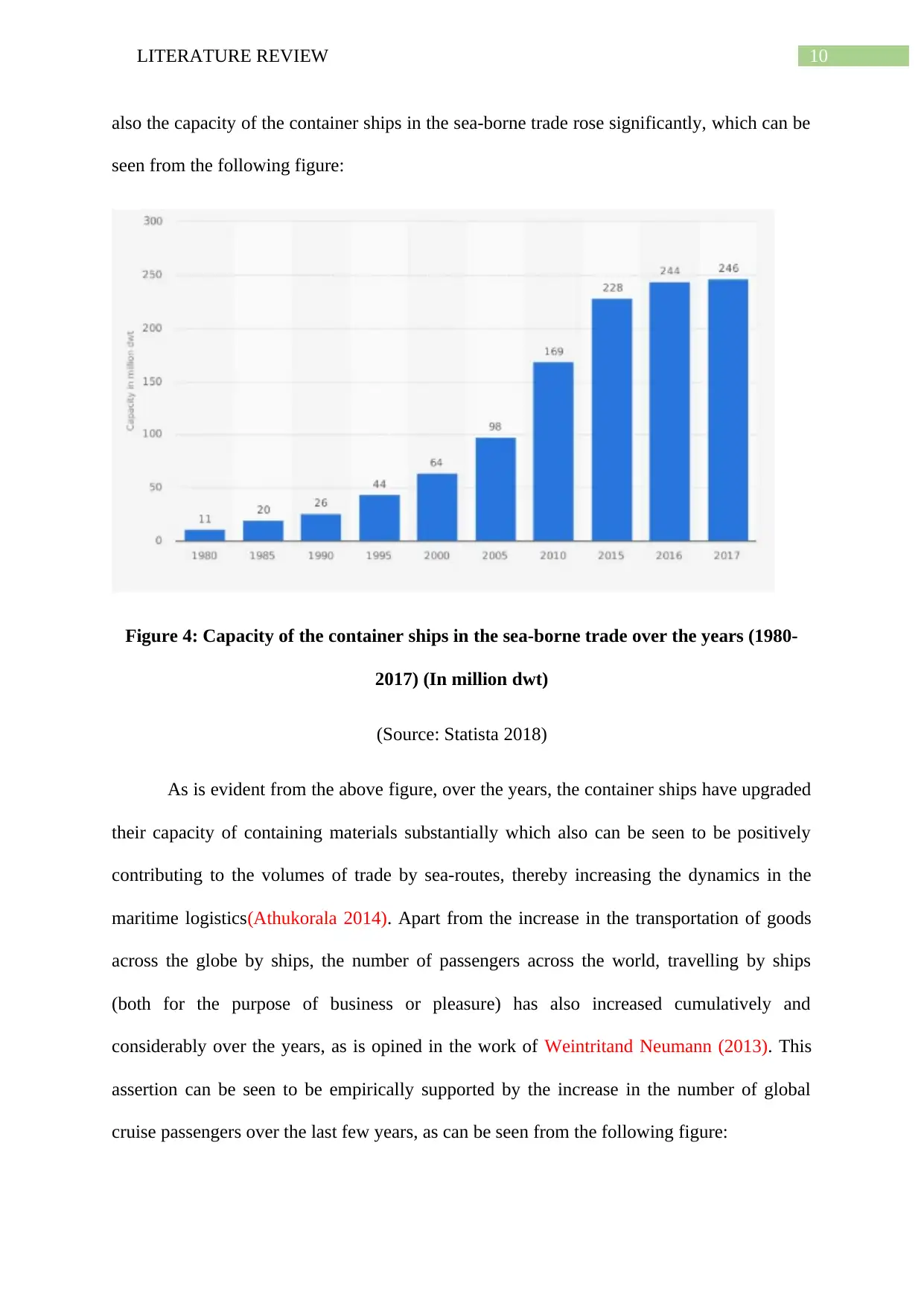
10LITERATURE REVIEW
also the capacity of the container ships in the sea-borne trade rose significantly, which can be
seen from the following figure:
Figure 4: Capacity of the container ships in the sea-borne trade over the years (1980-
2017) (In million dwt)
(Source: Statista 2018)
As is evident from the above figure, over the years, the container ships have upgraded
their capacity of containing materials substantially which also can be seen to be positively
contributing to the volumes of trade by sea-routes, thereby increasing the dynamics in the
maritime logistics(Athukorala 2014). Apart from the increase in the transportation of goods
across the globe by ships, the number of passengers across the world, travelling by ships
(both for the purpose of business or pleasure) has also increased cumulatively and
considerably over the years, as is opined in the work of Weintritand Neumann (2013). This
assertion can be seen to be empirically supported by the increase in the number of global
cruise passengers over the last few years, as can be seen from the following figure:
also the capacity of the container ships in the sea-borne trade rose significantly, which can be
seen from the following figure:
Figure 4: Capacity of the container ships in the sea-borne trade over the years (1980-
2017) (In million dwt)
(Source: Statista 2018)
As is evident from the above figure, over the years, the container ships have upgraded
their capacity of containing materials substantially which also can be seen to be positively
contributing to the volumes of trade by sea-routes, thereby increasing the dynamics in the
maritime logistics(Athukorala 2014). Apart from the increase in the transportation of goods
across the globe by ships, the number of passengers across the world, travelling by ships
(both for the purpose of business or pleasure) has also increased cumulatively and
considerably over the years, as is opined in the work of Weintritand Neumann (2013). This
assertion can be seen to be empirically supported by the increase in the number of global
cruise passengers over the last few years, as can be seen from the following figure:
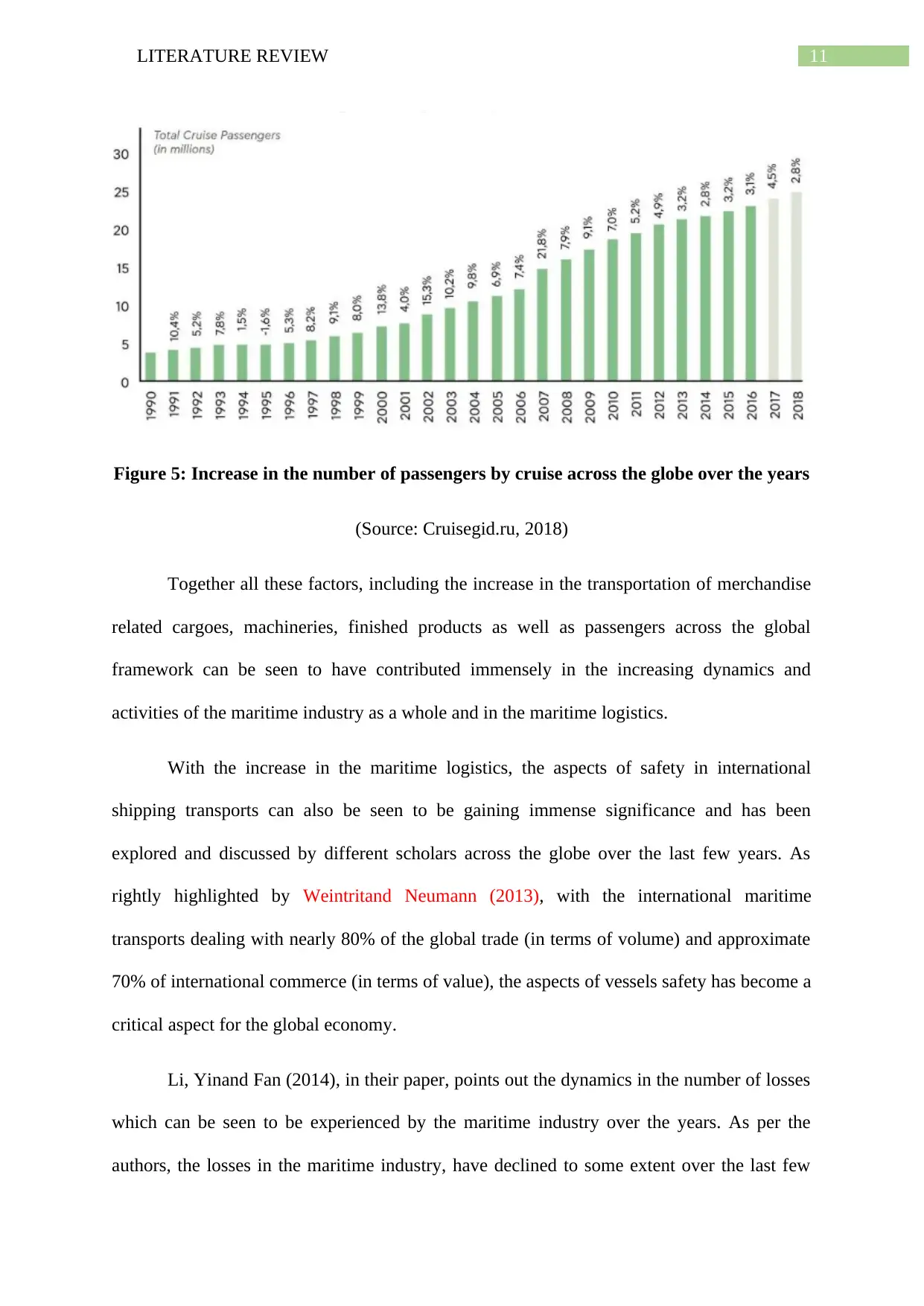
11LITERATURE REVIEW
Figure 5: Increase in the number of passengers by cruise across the globe over the years
(Source: Cruisegid.ru, 2018)
Together all these factors, including the increase in the transportation of merchandise
related cargoes, machineries, finished products as well as passengers across the global
framework can be seen to have contributed immensely in the increasing dynamics and
activities of the maritime industry as a whole and in the maritime logistics.
With the increase in the maritime logistics, the aspects of safety in international
shipping transports can also be seen to be gaining immense significance and has been
explored and discussed by different scholars across the globe over the last few years. As
rightly highlighted by Weintritand Neumann (2013), with the international maritime
transports dealing with nearly 80% of the global trade (in terms of volume) and approximate
70% of international commerce (in terms of value), the aspects of vessels safety has become a
critical aspect for the global economy.
Li, Yinand Fan (2014), in their paper, points out the dynamics in the number of losses
which can be seen to be experienced by the maritime industry over the years. As per the
authors, the losses in the maritime industry, have declined to some extent over the last few
Figure 5: Increase in the number of passengers by cruise across the globe over the years
(Source: Cruisegid.ru, 2018)
Together all these factors, including the increase in the transportation of merchandise
related cargoes, machineries, finished products as well as passengers across the global
framework can be seen to have contributed immensely in the increasing dynamics and
activities of the maritime industry as a whole and in the maritime logistics.
With the increase in the maritime logistics, the aspects of safety in international
shipping transports can also be seen to be gaining immense significance and has been
explored and discussed by different scholars across the globe over the last few years. As
rightly highlighted by Weintritand Neumann (2013), with the international maritime
transports dealing with nearly 80% of the global trade (in terms of volume) and approximate
70% of international commerce (in terms of value), the aspects of vessels safety has become a
critical aspect for the global economy.
Li, Yinand Fan (2014), in their paper, points out the dynamics in the number of losses
which can be seen to be experienced by the maritime industry over the years. As per the
authors, the losses in the maritime industry, have declined to some extent over the last few
⊘ This is a preview!⊘
Do you want full access?
Subscribe today to unlock all pages.

Trusted by 1+ million students worldwide
1 out of 31
Related Documents
Your All-in-One AI-Powered Toolkit for Academic Success.
+13062052269
info@desklib.com
Available 24*7 on WhatsApp / Email
![[object Object]](/_next/static/media/star-bottom.7253800d.svg)
Unlock your academic potential
Copyright © 2020–2026 A2Z Services. All Rights Reserved. Developed and managed by ZUCOL.





